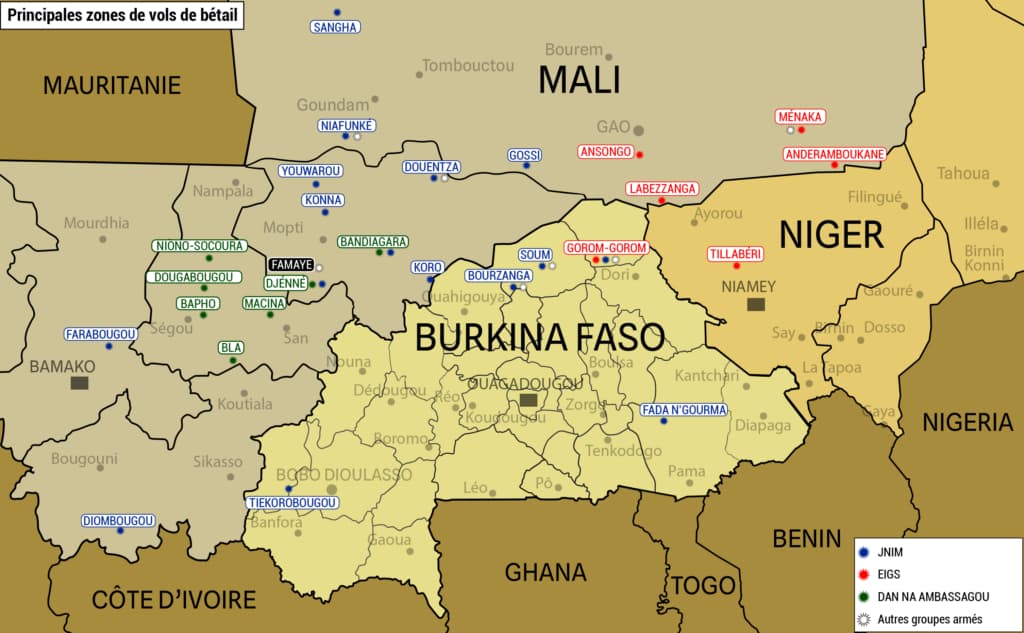Date : 28 Nov 2024
Terrorist financing in the Sahel: Strategies and impacts
Armed terrorist groups such as JNIM (al-Qaeda) and ISGS (Islamic State) use a variety of methods to finance and supply themselves in the Sahel: trafficking, looting of military camps, fraud… In the area, these maneuvers have a direct impact on both the civilian and military populations.
The Supply Mechanisms of Armed Groups in the Sahel
In the heart of the global epicenter of terrorism, armed groups obtain supplies in a variety of ways. Firstly, by setting up numerous raids in areas where turf wars are commonplace. Today, one out of every two deaths linked to the phenomenon occurs in Burkina Faso, Niger and Mali, according to the Institute for Economics and Peace’s (IEP) Global Terrorism Report 2024.
Convoys and villages are pillaged. On April 14 in Mali, some fifty JNIM supporters attacked a Dan Na Ambagassou camp on the RN15, in the heart of Dogon country between Bandiagara and Goundaka. A dozen dozo hunters died, and five were wounded. Called in by the local population, the police arrived too late to limit the human toll. On April 11 in Burkina Faso, a supply convoy bound for Djibo was targeted: two trucks were set on fire and at least two people were killed. On April 5, in Niger, a vehicle belonging to the NGO CADEV-Niger was reportedly kidnapped by armed men between Diffa and Mainé-Soroa. The driver was killed. These are just a few of the attacks perpetrated on the population.
Nor are civilians the terrorists’ only targets. In the Sahel, the authorities in place are struggling to push back these resupply operations on their own camps. On March 31 in Burkina Faso, the village of Tawori came under siege at around 5pm. More than 350 JNIM-affiliated terrorists stormed the FDS camp. The attack left 73 dead, including 32 civilians, 25 Volunteers for the Defense of the Homeland (VDP) and 16 FDS. It enabled the jihadist group to loot a large quantity of weapons, ammunition, communications equipment and several vehicles.
Manufactured in Russia, Eastern Europe and China, the weapons were mainly stolen from local military camps and the VDP.
The economy of Sahelian terrorism

Terrorist armed groups are financed by low-level fraud, robbery and kidnapping for ransom of civilians following attacks, misappropriation of NGO funding, as well as the insertion of the terrorist sphere into the black market.
In sub-Saharan Africa, terrorism and the level of criminal activity are intrinsically linked.
The interaction between drugs, organized crime and terrorism is simply a function of the specific political and economic dynamics of the region.
Dr. Timothy Wittig - Scientist and author of the book "Understanding Terrorist Finance".
Gold, livestock, drugs, medicines, electronic currencies… the goods involved in this trade are numerous.
Gold mining accounts for 90% of GAT revenues. According to mining journalist Elie Kaboré: “The terrorist threat affects all mines in Burkina Faso. Mines that are not attacked invest huge sums of money in transporting workers. Added to this are the costs of securing land convoys for supplies. This increases mine operating costs. To cope with this, jobs are threatened”.
During phases of territorial expansion, these attacks are all the more frequent. In Mali, the end of 2022 saw a large number of cattle thefts and hostage-takings. This was due to the escalating conflict with the Islamic State in the Greater Sahara (ISGS).
According to IEP, 126,000 head of cattle were stolen between 2018 and 2020 in the Mopti region alone.
Recruitment: between manipulation and blackmail
These activities contribute to strengthening the recruitment capabilities of the terrorist sphere in the Sahel. Some join the jihadist ranks out of distrust of state policies. Others do so because of rivalries fuelled by inter-community theft. In fact, terrorist propaganda exploits divisions and cultural tensions within local and regional populations. In addition, young people are abducted from their villages. These are then raised by the terrorists, who provide protection for the localities they come from. Many of the soldiers of the terrorist groups present in the area also come from pre-existing criminal organizations.
More generally, the GATs put pressure on villagers to indirectly support the cause. Originally a religious charity tax, the “Zakât” is collected by these various groups from the population, under the passive gaze of the local authorities.